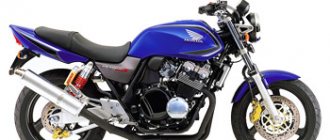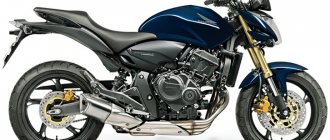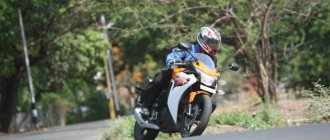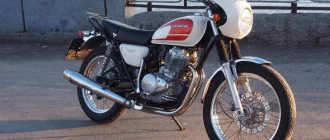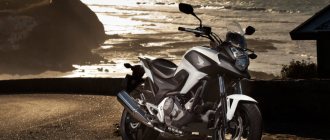Supersport class motorcycle Honda CBR600RR, Honda SBR 600 RR, Honda CBR 600
The supersport motorcycle Honda CBR600RR (Honda SBR 600 RR) first appeared in the production program in 2003.
The engineers were given the task of developing a road version of the famous Honda RC211V racing car, competing in the Moto Grand Prix class. The owners received a beautiful car, equipped with the latest technical innovations of those years, including the Unit Pro-Link rear shock absorber and injection technology with 2 injectors per cylinder. Over time, the Honda CBR 600 received regular updates and upgrades to live up to its image as a flagship sports bike.
The engine is 600 cc, 4-cylinder in-line, water-cooled and has a high power density, producing up to 120 hp. With. and 66 Nm at the rear wheel. The cbr600rr engine settings give excellent results in the upper crankshaft speed range, with peaks developing at 11-13 thousand revolutions.
The Honda CBR 600 RR has an aluminum frame, the suspension has a full range of adjustments, and the steering column is equipped with an electronically controlled damper. At the owner's request, the cbr600rr brake system can be equipped with a combined type ABS.
Honda CBR600RR, cbr600rr
History of changes
The Honda 600cc received its first modernization 2 years after the start of production - in 2005. The appearance has changed, the geometry of the aluminum frame, the front and rear brake calipers have become radial. The front fork and rear suspension have new geometry and a full range of adjustments. The Honda CBR600RR has become 4 kg lighter, and the engine has increased traction at mid-speed.
In 2007, engineers developed a new Honda 600 motorcycle engine, significantly lighter and more compact. The frame was narrowed a little, and the weight was also reduced by 9 kg. The appearance and aerodynamics have been improved again. The steering wheel began to be equipped with an electronically controlled damper.
Since 2009, the developers, by modernizing the pistons, cylinder block and exhaust system, have increased traction at high speeds, and began to offer the installation of ABS as an option.
In 2013, tuning of the wheel rims took place. The new engine control program allowed it to produce even more thrust. The front fork was replaced with a new Showa, the rear suspension of the Honda SBR 600rr received updated settings.
Honda CBR600RR, Honda 600cc
Technical description (Honda cbr600rr specifications)
The Honda SBR 600 RR is equipped with a 599 cc 4-cylinder power unit with an overhead valve mechanism (DOHC) and a liquid cooling system. The maximum torque indicator did not change and amounted to 66 Nm at 11,250 rpm.
The first model produced the highest power of 117 hp. With. at 13 thousand rpm. Since 2007, the compression ratio has been slightly increased and reached 12.2 (from 12.0). Due to this and other technologies, the power initially increased to 118 hp. With. at 13,500 rpm, and from 2013 – up to 120 hp. With. at the same speed. The engine is started using an electric starter.
The fuel injection system used 2 injectors per cylinder technology with electronically controlled injection. But the first Honda SBR 600pp models had single-injection injectors, and since 2007, distributed 12-point injection began to be used.
Video review of Honda CBR600RR
The manual transmission has 6 speeds, a multi-plate clutch in an oil bath. Chain drive to the rear wheel.
Tires size 120/70 ZR 17 at the front and 180/55 ZR 17 at the rear.
The front brake mechanism is double-disc, with 4-piston calipers and a 310 mm disc. Since 2005, the calipers have become radial. The rear brake is single disc, 1-piston, with a 220 mm disc.
Since 2013, a combined anti-lock braking system (ABS) has become available as an option. The front fork on motorcycles of different generations was of different types. First, a straight telescope with cartridges and 45 mm nibs was installed. After 2005 - an inverted cartridge-type telescope with 41 mm feathers. Since 2013 - inverted Big Piston Fork. The only thing they have in common is the presence of a full range of adjustments. The rear swingarm with Unit Pro-Link HMAS monoshock and all adjustments has undergone fewer changes. Until 2005, the suspension travel was 120 mm, then 130 mm.
The weight was steadily decreasing: the first CBR600RR models weighed 167.8 kg, since 2005 - 163.7 kg, and since 2007 - already 154.7 kg.
Specifications (honda cbr600rr specifications):
- maximum speed – 251-257 km/h;
- acceleration from zero to 100 km/h – from 3 to 3.1 seconds;
- fuel reserve - 18 l;
- fuel consumption – 6.8-7 l/100 km.
Honda CBR 600RR. honda cbr600rr specifications
Motorcycle review and history of Honda CBR 600RR (2007)
Motorcycle review and history of Honda CBR 600RR (2007)
A lighter crank and lighter cranks mean lighter—and smaller—everything else, so the entire package, capped by lighter 11-ounce magnesium valve covers, is 27.5mm shorter than 2006 while increasing power and torque moment and weighing 3.7 pounds less.
"The clutch is lighter, smaller and stronger, and the transmission gets closer ratios and is redesigned to reduce drive gap."
The engine improvements don't stop there. We didn't have any complaints about last year's clutch or transmission, but Honda has improved them anyway. The clutch is lighter, smaller and stronger, and the transmission gets closer ratios and is redesigned to reduce driveline shock.
There's also a new gadget called an intake air control valve (IACV) that smooths out the throttle response, avoiding the fuel-injection-induced harsh responses that some other bikes are cursed with. The airbox, which now sucks air through an opening at the front of the frame like the RC-51, gets seven percent more extra power, and the radiator is 40mm narrower but 34.2mm taller, so not too much frontal space is lost. The exhaust now has titanium baffles; they could have demonstrated it, as some OEMs do, but they put it where it would benefit the most.
Suspension and brakes are standard, if effective, fare. Up front, fully adjustable (except for speed settings) 41mm inverted forks and four-piston radial-mount calipers do the work (though Toland said new braking components provide more feel), while at the rear, a Honda Unit Pro-Link is bolted to a shock absorber that's adjustable in three directions. The Unit Pro Link shock link is GP technology for the street; it almost completely isolates the suspension from the frame, providing the smoothest ride possible.
Honda's Electronic Steering Damper (HESD), half the size (and 20 percent lighter) of last year's shock, keeps the compact chassis—with a steeper front end than the old car—in check, adjusting damping force based on speed.
To wrap up the package, Honda's added a thicker seat (although this is a road course, just like a DOT race tire on dry pavement. I say "probably" because I didn't want to be that guy who pushed it too hard in the rain and crunched a brand new bike: I was happy at 8/10 pace. The increased traction allowed me to calm down and really feel the suspension, braking and other qualities of the machine. With a team of Honda technicians on hand to ensure perfect tuning, the suspension felt precise, even if they misjudged my weight by 20 lb. Although the track is very smooth, there is some road surface wobble in one high speed braking zone (some, Grand Am cars!) which results in some potholes, but I think any bike would bounce off The back is straight, the front gets light, but the HESD shutter works fine and there is no drama.
Serious sportbike riders have been eagerly awaiting the arrival of the powerful new 2007 Honda CBR600RR , and now industry experts have confirmed that this incredible machine was worth the wait. Cycle News was crowned with a middleweight victory in the 600cc Shockout class. See the smaller, more powerful and lighter 2007 Honda CBR600RR easily outpace the competition both on the track and on the street. Roadracing World went one better, calling the 2007 Honda CBR600RR "the best 600cc sportbike ever." The praise doesn't get much higher. And performance doesn't.
The most radical redesign of the CBR® 600 since the RR's introduction in 2003 was highlighted by an all-new engine, frame and body, resulting in a smaller, lighter and more powerful Honda CBR600RR with class-leading power-to-weight ratio and unparalleled performance.
Features and benefits of the Honda CBR 600RR motorcycle (2007)
New for 2007
- Best-in-class power-to-weight ratio for outstanding acceleration and handling.
- Smaller, lighter, more compact inline-four engine.
- Improved mid-range performance and increased peak power.
- Significant weight reduction in engine and chassis.
- Repositioned transmission shafts inside the engine crankcase allow the engine to be shortened.
- New lightweight forged aluminum pistons are specially shot peened for added strength. - Lightweight magnesium head cover.
- New, single exhaust valves
- springs.
- Smaller, lighter sodium magnet ACG.
- New gear ratios.
- Smaller, lighter clutch.
- New master cylinder system with vertical piston and front brake.
- The lightweight stainless steel four-into-one exhaust features a new integrated exhaust valve to control exhaust pressure for maximum performance.
- A new intake air control valve (IACV) minimizes torque response and smoothes response to small throttle changes by gradually reducing air and fuel flow as the throttle valve opens and closes. - New non-resonant knock sensor maintains optimal spark advance while constantly monitoring combustion characteristics during mid- and high-speed operation.
- A new nose-mounted air induction forces fresh, cool air into a larger volume airbox.
- New smaller and lighter electronic power steering (HESD).
- The newly developed Fine Die-Cast (FDC) frame uses four large castings to reduce weight.
- Improved mass centralization.
- Redesigned radiator with compact dimensions improves cooling performance.
- An all-new body improves handling and performance.
- The steering wheel is raised by 10 mm to improve driver comfort.
- The center of gravity has been revised for a more neutral response and easier lateral movement.
- New, compact tool design.
- Exciting new colors - Pearl White/Silver and Ultra Blue Metallic/Silver - combine Red/Black and Black as color options.
Engine/Transmission of Honda CBR 600RR motorcycle (2007)
- Liquid-cooled DOHC 599cc two-stroke, four-stroke, four-cylinder engine. cm / 36.5 cu.
- The intake port surface treatment has been revised to improve efficiency.
- The oil jet moves under the piston to further reduce friction and provide cooling.
- Iridium spark plugs improve combustion and performance.
- The DSFI system has 40mm throttle bodies and two injectors per cylinder - one upper and one lower, controlled by an electronic control unit (ECU) that senses speed and throttle opening. The bottom injector improves drivability, while the top injector improves engine power.
- Denso 12-hole injectors deliver a finely atomized fuel mixture for optimal combustion efficiency and power.
- The automatic enrichment system is integrated into the Programmed Fuel Injection Module (PGM-FI), eliminating the need for a manual throttle.
- The two-stage piston air system delivers a large volume of cool air into the airbox for linear power delivery and incredible engine performance.
- The cylinder head features angled valve inserts to improve airflow.
- The cylinder head has two springs per intake valve and one spring per exhaust valve for optimal high-rpm valve performance and durability.
- Direct actuation of the lining valve under the bucket ensures high performance and durability with 10,000 mile service intervals.
- Lighter pistons and lighter nutless connecting rods contribute to faster acceleration.
- Double tensioner for cam chain durability.
- The right starter gears allow you to increase the angle of inclination.
- The smooth-shifting six-speed transmission with close ratios and new ratios is closely linked to the engine's powerband.
Chassis / Suspension Honda CBR 600RR (2007)
- HMAS n-41mm cartridge front fork with adjustable spring preload, rebound and compression damping for precise action. n - Unit Pro-Link - rear suspension system inspired by the RC211V GP racer. With this two-piece shock system, the top shock mount is located inside the swing arm rather than the frame. With no upper frame shock mount, this unique system reduces negative suspension energy transferred to the frame, providing optimal frame stiffness and improved cornering handling.
- The braking system features two four-piston radial front calipers, two 310mm front discs and one 220mm rear disc for optimal stopping power.
- The new vertical piston master cylinder system provides superior front brake lever ratio for greater braking performance with superior feel and control. This layout allows the use of a longer brake lever, which means more braking force with less effort from the driver.
- Lighter aluminum steering rod. Additional features
- Industry-leading ergonomic design provides maximum rider comfort for minimal fatigue in all riding conditions.
- The centrally mounted 4.8-gallon fuel tank sits low in the frame, increasing mass centralization and allowing for a more compact design.
- A plastic tank housing cover protects the tank and air chamber.
- The linear headlights feature a three-piece reflector design that uses two H7 bulbs for optimal light distribution and a unique compact design.
- New devices are very compact and equipped with LCD
- panel with tachometer, odometer, speedometer with two speedometers, fuel gauge and clock.
- The attractive hollow-spoke aluminum alloy wheels feature racing specs of 3.5 x 17.0 inches at the front and 5.5 x 17.0 inches at the rear.
- One-piece fan block for maximum cooling efficiency.
- Maintenance free battery.
- Additional seat cover.
- Compact rear hood storage compartment for U-locks (lock not included) under passenger seat. — Rotating, aerodynamic mirrors.
- Built-in ignition switch/plug for added safety.
- Convenient push-button rotary switch.
Additional information on this year's motorcycle:
1. Motorcycle review and history of the Honda CBR 600RR
Motorcycle review and history of the Honda CBR 600RR motorcycle
- Motorcycle review and history of Honda CBR 600RR (2003-2018)
2.Technical characteristics of the Honda CBR 600RR motorcycle
Technical characteristics of the Honda CBR 600RR motorcycle
- Technical characteristics of the Honda CBR 600RR motorcycle (2003-2018)
3.Honda CBR 600RR motorcycle repair video
4.Video: reviews, test drives, comparisons, 0-100 km/h of the Honda CBR 600RR motorcycle
5.Service manual and documentation for the Honda CBR 600RR motorcycle
6. Reviews from owners of the Honda CBR 600RR
7.Test drives of the Honda CBR 600RR motorcycle
Test drives of the Honda CBR 600RR motorcycle
Check out the test drives:
- Test drive Honda CBR 600 RR from Motorreview magazine
- Comparison test Honda CBR600RR vs Kawasaki ZX - 10R vs Suzuki GSX -R750
IMPORTANT INFORMATION!!!
Subscribe to our Moto news in the VKontakte group Moto-Encyclopedic Portal.
Dear guests of our project, you have the following options: 1) if you have any questions about repairing your motorcycle, you can Go to the forum of your motorcycle and our qualified specialists, 2) at the end of each page you can leave a comment, while registering Go , by going to it you register and then return to this page and update it with the F5 key and leave your comment 3) “Additional information on this motorcycle this year” will help you learn more about your motorcycle.
Article read by: 1,537
Add a comment Cancel reply
You must be logged in to post a comment.
Performance evaluation of the Honda CBR 600
The Honda CBR600RR review starts with the exterior. The motorcycle evokes admiration for its carefully crafted exterior, filigree design lines and functionality of appearance elements.
But the main strengths of the Honda CBR600RR as a motorcycle lie on the inside. The creators tried to distinguish it from its competitors with its ability to quickly accelerate and stop just as quickly, maintain directional stability at maximum speeds and behave predictably in extreme conditions. They always try to emphasize its speed and technical characteristics in photos and videos.
Those who are choosing a supersport motorcycle for the first time should know a certain ergonomic feature: machines of the 600 cm³ class will only be comfortable for people with a height of no higher than 175 cm. This is a feature not only of the Honda CBR 600RR, but also of all devices in this class. Taller riders should look for a higher-end bike.
2003 models were only available in 2 color schemes. In 2004, they were expanded to 4, and in 2013 – to 6. Separately, it is worth mentioning the Honda CBR600RR Limited Edition package, released in limited edition in 2010. The motorcycle's livery features black and white graphics and a stylized female face on the sides.
Honda CBR600RR Limited Edition, Honda CBR 600 RR photo
Concluding the review of the Honda cbr600rr, it is necessary to note the highest quality of the motorcycle. Japanese-made equipment has always shone with reliability, excellent level of assembly and durability. But even among its Japanese competitors, Honda stood out favorably with engines and gearboxes. This is confirmed by both sporting successes and popularity among buyers.
Honda CBR600RR Limited Edition
Post Views: 5,346
It’s no secret, but the most painful problem with the 600rr is the relay regulator and the accompanying problems when it fails, which, in fact, happened to me, namely: overcharging and the battery subsequently boiling (fortunately it boiled, but it could I should have slammed it, as I was told). Actually, this is what the battery looked like when recharged at 16+ volts (it rang already on a new battery):
In general, the question arose about buying a new regulator relay, but after looking at the prices for the original relay, I felt uneasy... but the failure of this device is a fairly common problem =/ Okay, what should I do? I continued to look for a way out of the situation - the second option was to buy a Chinese one... but alas, it was not suitable due to its work (for some it was a day, for others it was a month, for others it was rolled for years and sold along with the motor), I decided try your luck and buy (maybe it’ll give you a ride =/), yeah... it worked for a week) I freaked out pretty bad, but the third option was spinning in my head, which had been ridden by not a single motorcycle, and a friend encouraged me, they say, it will work with a bang and “forever” =) this one third option: homemade relay using a twist circuit
Yes, but I don’t know how to solder... I don’t understand a thing and I didn’t really believe it would work, but the same friend (https://bikepost.ru/profile/Freez/) promised to help out and solder the unfortunate relay and save me from an assortment of options and tape measures in choosing a regulator relay (for which I am very grateful to him) Turning to a friend, I was given a list of parts for soldering the regulator (1,680 rubles at the time of purchase, except for thermal paste, wires and epoxy resin):
(for which I am very grateful to him) Turning to a friend, I was given a list of parts for soldering the regulator (1,680 rubles at the time of purchase, except for thermal paste, wires and epoxy resin):
- KBPC5006, Diode bridge 50A 600V [KBPC] [=MB5006] 3 pieces;
- ULN2003A, Array of seven Darlington transistors, 500mA, [DIP-16] 3 pieces;
- CF-100 (C1-4) 1 W, 300 Ohm, 5%, Carbon resistor 5 pieces;
- K10-17B M47 1000pF, 10%, Ceramic lead capacitor 1 piece;
- 1N4740A, Zener diode 10V, 5%, 1W, DO-41 1 piece + 1N4732A, Zener diode 4.7V, 5%, 1W, [DO-41] 1 piece;
- radiator 1 piece;
- epoxy resin;
- thermal paste;
- 2 meters of 4x3 multi-core wires.
(thermal paste took v1 ic value for those interested, for 350 rubles)
As a result, I drove the motor to a friend’s garage and we sat down to work... until the friend started soldering the relay, I disassembled the motor to throw the wires for installation in the tail (yes, the regular place for the regulator on the RR is located near the engine and cooling radiator under the plastic , from which it quickly overheats and just as quickly burps =/) Soldering turned out to be a chore (due to my knowledge, I helped as much as I could) - almost the whole day of fun, in total, with breaks for drinking, eating, talking... the finished relay after adjusting to The voltage ( 14.4 volts with the lights and low beams on ) and without epoxy looked like this:
and here is the final result:
it looks weighty, solid, inspires confidence =), no matter how... but how to install it?!?!?! this is the 600RR and its super missing space in the trunk =/ in short, with light movements of a hacksaw I hacked the already collective farm relay (please don’t judge strictly, there was nothing to do):
but it fit into a tiny corner under the passenger seat:
video of the
operation of the relay in the cold and when warming up PS the motor sat in the garage for a week (after soldering the relay) and the battery was slightly recharged and after driving for 100 km the voltage settled down and did not jump - it began to show around 14 (13 on the voltmeter): voltage at battery number one voltage on battery number two voila... you can forget about the problem or...???
Let me summarize: The prices for the original are steep (there is no guarantee of long service - a pain); Prices for original used ones are like China, but also like China - a pig in a poke; Prices in China are attractive (there’s nothing to say here at all, it wouldn’t even be a pain, it’s all the same: a day, a week, a month, a lifetime of work). Prices for homemade products attract more from China (and the amperage can be made more), but the very essence of “homemade”... you understand) we will test in battle, so what... As the manufacturer said (https://bikepost.ru/profile/Freez/ ) “yes, it’s eternal” and something about a reserve of 50A (alas, this doesn’t tell me anything :D).
Please do not criticize me since I am a beginner and am just learning the technique, (naturally) asking not very smart questions from my motorcycle brothers and my comrades, and also learning experience along the way, so that later I will be able to help the same green ones =)

